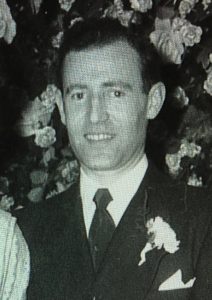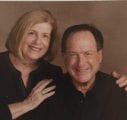- Local Survivor registry
- HYMAN TUCHMAN
- Local Survivor registry
- HYMAN TUCHMAN
Survivor Profile

HYMAN
TUCHMAN
(1922 - 1981)
PRE-WAR NAME:
HYMAN TUCHMAN
HYMAN TUCHMAN
PLACE OF BIRTH:
TYCHEN, POLAND
TYCHEN, POLAND
DATE OF BIRTH:
APRIL 17, 1922
APRIL 17, 1922
LOCATION(s) BEFORE THE WAR:
TYCHEN, POLAND
TYCHEN, POLAND
LOCATION(s) DURING THE WAR:
PLASZOW AND MAUTHAUSEN CONCENTRATION CAMPS
PLASZOW AND MAUTHAUSEN CONCENTRATION CAMPS
STATUS:
SURVIVOR
SURVIVOR
RELATED PERSON(S):
MIRIAM BERKOWITZ TUCHMAN - Spouse (Deceased),
AARON TUCHMAN, BROTHER ,
HELEN TUCHMAN ROSEN - Daughter,
SAM TUCHMAN - Son,
ROBYN ROSEN BILMES - Granddaughter,
MATTHEW BILMES, Great- - Grandson,
MORGAN BILMES, Great- - Granddaughter,
JESSICA ROSEN FREUND - Granddaughter,
ZACHARY FREUND, Great- - Grandson,
MADELYN FREUND, Great- - Granddaughter,
ABIGAIL FREUND, Great - Granddaughter
-
BIOGRAPHY BY HELEN ROSEN
Hyman was born in Tychen, Poland on April 17, 1922. He lost everyone in his family during the Holocaust with the exception of one brother, Aaron. My father came from a large family of several brothers and several sisters. He was a leather craftsman in Europe before the war, but when he came to the states, he chose to have a grocery/deli as he understood hunger all too well. I knew at a very young age that my father had been in a camp because I once questioned why he didn’t drive. He had a grocery store in Newark, and my mother, Miriam would drive him to work very early, drive back while we, the children were still asleep, and pick him up at night to bring him home. Even though it was a grocery/deli, my mother would drive back midday with a hot lunch for my father to eat. When I was old enough to understand, I was told that while in the camp, my father was beaten for giving some potato peels to others in the camp. Part of the whip caught his eye, and he lost the sight in one eye. My mother always feared that if a piece of dust got in one eye, he wouldn’t be able to see with the other and might get into an accident. (In those early days, cars weren’t air-conditioned and the windows were usually open). My father generally did not speak about his Holocaust experiences to me.
After the war, my father went to Italy; his brother to Palestine. While in Italy, he worked with the Joint Distribution Committee and was highly regarded by the local police. Although he made very few references to his past, I remember one time watching the mini series on television called Holocaust with James Woods and Meryl Streep (some time in the late 1970s). I called my father to ask if he was watching. His reply was “Nash kindt…if you can see it on television, it’s nothing like it was.” The survivors, at least the ones my father was friendly with, and there were many, all settled in Hillside, New Jersey, spoke of their experiences with one another, but not to anyone else. Most felt they wanted to spare their children their pain, and secondly, most felt that their children could not possibly comprehend such evil…my father was no different.
In my early twenties, my father was in a car accident. When they treated him in the emergency room, the lab work indicated a very high white blood cell count. That led to further examination, and it was determined that he had chronic lymphocytic leukemia. My mother asked the doctors not to tell him that he had a blood cancer but to play it down as a serious case of anemia. She felt that he had been through so much, he did not need to know the diagnosis, nor did she want anyone to pity them. They were extremely strong, proud people.So for many years, my father truly did not know his diagnosis.
Some years later when my parents traveled to Israel to see my father’s brother, my father happened to come across a letter my mother carried with her in the event he needed emergency care which had his diagnosis. Once he learned of it, he said that he must have gotten it as a result of the car accident because in the camps, they had to run barefoot in all weather conditions and he always healed. Obviously, one had nothing to do with the other, but the reason I mention it is that was something he shared about a camp. After my father passed away in 1981, one of his friends shared with me that my father was in several camps. The two I know about are Plaszow and Mauthausen.
Editor’s Note:
Refer to Helen Rosen in Voices of the Descendants
Refer to Historical Notes Below for Plaszow and Mauthausen Concentration camps
-
SURVIVOR INTERVIEW:
Refer to the Biography above by Helen Rosen, daughter
-
HISTORICAL NOTES:
Plaszow and Mauthausen concentration Camps
The camp of Plaszow was originally designed to be a work camp. However, like many other Nazi camps, shortages of food existed, prisoners starved or were worked to death, or summarily shot for no reason. The camp had been opened in December 1942. More than 150,000 civilians were held prisoner in Plaszow.
One use of slave labor was to obliterate all trace of earlier mass murders. At Himmler’s instigation, a series of special units, known collectively as Unit 10051, were forced to dig up the putrefied corpses of those slain, to burn them, and scatter the ashes. This work took nearly two years and involved exhuming more than two million corpses. At Plaszow, in January 1945 a Unit 10051 was forced to exhume 9,000 bodies from 11 mass graves.
Other units, working at different times at the murder sites, were themselves murdered once their work was done. The SS wanted no trace to survive either of their crimes, or of the slave laborers who were being forced to hide them.
The conditions of life in this camp were made dreadful by the SS commander of the camp Amon Goeth . A prisoner in Plaszow was very lucky if he could survive in this camp more than four weeks. After the liberation, commander Amon Goeth had been turned over to the Polish officials, tried, sentenced to death and hanged. The camp shown in Spielberg’s film “Schindler’s List” is the exact description of Plaszow. Life for the inmates was usually short and miserable.
As the Russian forces advanced further and further westward, the Germans began the systematic evacuation of the slave labor camps in their path. From the camp at Plaszow, many hundreds were sent to Auschwitz, others westward to Mauthausen and Flossenburg on January 18th, 1945, the camp was evacuated by Death Marches, during which thousands of prisoners died from starvation, disease or were shot if they were too weak to walk.. The last prisoners were transferred to Germany on January 16th, 1945.
-
Sources and Credits:
Credits:
Biography by Helen Tuchman Rosen ; Family photographs donated by Helen Tuchman Rosen




